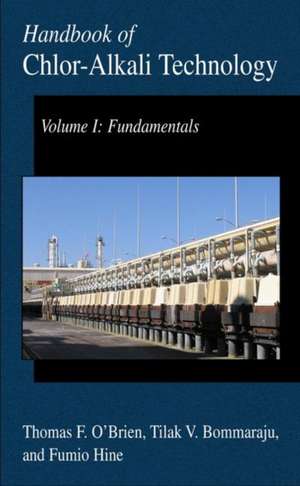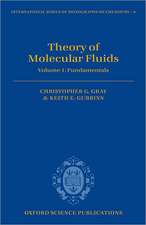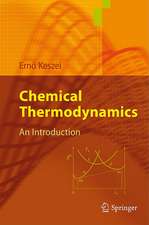Handbook of Chlor-Alkali Technology: Volume I: Fundamentals, Volume II: Brine Treatment and Cell Operation, Volume III: Facility Design and Product Handling, Volume IV: Operations, Volume V: Corrosion, Environmental Issues, and Future Developments
Autor Thomas F. O'Brien, Tilak V. Bommaraju, Fumio Hineen Limba Engleză Hardback – 31 aug 2005
The last feature named above has relieved the authors of this work of the obligation to cover applications in any detail. Instead, they provide a concentrated treatment of all aspects of technology and handling directly related to the products of electrolysis. It covers the field from a history of the industry, through the fundamentals of thermodynamics and electrochemistry, to the treatment and disposal of the waste products of manufacture. Membrane cells are considered the state of the art, but the book does not ignore mercury and diaphragm cells. They are considered both from a historical perspective and as examples of current technology that is still evolving and improving. Dear to the heart of a director of Euro Chlor, the book also pays special attention to safe handling of the products, the obligations of Responsible Care®, and process safety management.
Other major topics include corrosion, membranes, electrolyzer design, brine preparation and treatment, and the design and operation ofprocessing facilities. Perhaps uniquely, the book also includes a chapter on plant commissioning. The coverage of membranes is both fundamental and applied. The underlying transport processes and practical experience with existing types of membrane both are covered. The same is true of electrolyzer design. The book explores the basic electrode processes and the fundamentals of current distribution in electrolyzers as well as the characteristics of the leading cell designs. The authors have chosen to treat the critical subject of brine treatment in two separate chapters. The chapter on brine production and treatment first covers the sources of salt and the techniques used to prepare brine. It then explains the mechanisms by which brine impurities affect cell performance and outlines the processes by which they can be removed or controlled. While pointing out the lack of fundamental science in much of the process, it describes the various unit operations phenomenologically and discusses methods for sizing equipment and choosing materials of construction. The chapter on processing and handling of products is similarly comprehensive. Again, it is good to see that the authors have included a lengthy discussion of safe methods and facilities for the handling of the products, particularly liquid chlorine. While the discussion of the various processing steps includes the topic of process control, there is also a separate chapter on instrumentation which is more hardware-oriented.
Other chapters deal with utility systems, cell room design and arrangement (with an emphasis on direct current supply), alternative processes for the production of either chlorine or caustic without the other, the production of hypochlorite, industrial hygiene, and speculations on future developments in technology. There is an Appendix with selected physical property data.
The authors individually have extensive experience in chlor-alkali technology but with diverse backgrounds and fields of specialization. This allows them to achieve both the breadth and the depth which are offered here.
The work is divided into five volumes, successively treating fundamentals, brine preparation and treatment, production technology, support systems such as utilities and instrumentation, and ancillary topics. Anyone with interest in the large field of chlor-alkali manufacture and distribution, and indeed in industrial electrochemistry in general, will find something useful here. The work is recommended to students; chlor-alkali technologists; electrochemists; engineers; and producers, shippers, packagers, distributors, and consumers of chlorine, caustic soda, and caustic potash.
This book is thoroughly up to date and should become the standard reference in its field.
Barrie S. Gilliatt, Executive Director, Euro Chlor
Preț: 2717.00 lei
Preț vechi: 3528.57 lei
-23% Nou
Puncte Express: 4076
Preț estimativ în valută:
519.96€ • 564.60$ • 436.77£
519.96€ • 564.60$ • 436.77£
Carte tipărită la comandă
Livrare economică 18-24 aprilie
Preluare comenzi: 021 569.72.76
Specificații
ISBN-13: 9780306486234
ISBN-10: 0306486237
Pagini: 1580
Ilustrații: LXXXVI, 1580 p. In 5 volumes, not available separately.
Dimensiuni: 178 x 254 x 114 mm
Greutate: 3.79 kg
Ediția:2005
Editura: Springer Us
Colecția Springer
Locul publicării:New York, NY, United States
ISBN-10: 0306486237
Pagini: 1580
Ilustrații: LXXXVI, 1580 p. In 5 volumes, not available separately.
Dimensiuni: 178 x 254 x 114 mm
Greutate: 3.79 kg
Ediția:2005
Editura: Springer Us
Colecția Springer
Locul publicării:New York, NY, United States
Public țintă
Professional/practitionerCuprins
Fundamentals.- History of the Chlor-Alkali Industry.- Overview of the Chlor-Alkali Industry.- Chemistry and Electrochemistry of the Chlor-Alkali Process.- Brine Treatment and Cell Operation.- Chlor-Alkali Technologies.- Process Overview.- Brine Preparation and Treatment.- Facility Design and Product Handling.- Cell-Room Design.- Product Handling.- Plant Commissioning and Support Systems.- Chemical Engineering Principles.- Instrumentation and Control Systems.- Utilities.- Plant Commissioning and Operation.- Corrosion, Environmental Issues, and Future Development.- Corrosion.- Alternative Processes.- Environmental Safety and Industrial Hygiene.- Future Developments.
Notă biografică
Tom O’Brien has spent approximately twenty-five years of his chemical engineering career in the electrochemical field. In addition to many technical studies, safety reviews, and consulting assignments, he has been deeply involved in the engineering, construction and commissioning of more than twenty-five operating plants in sixteen different countries producing chlorine, bromine, phosgene, ethylene dichloride, solid and liquid alkalis and sodium chlorate. Since his retirement in 1999, he has performed selected consulting assignments for worldwide clients.
Dr. O’Brien is currently working on two other books, one dealing with Sherlock Holmes, the other a mathematical analysis of baseball statistics.
Tilak V. Bommaraju received his PhD in Chemistry in 1967 from Banaras Hindu University in India. He was a post doctoral fellow at the state University of New York at Buffalo and at the University of Ottawa.
Dr. Bommaraju has worked as a research chemist for the International Nickel Company of Canada, performing research and development in the electrometallurgy of Ni, Cu, and Zn. He has also worked as a Senior Scientist and Technical Manager for Chlor-Alkali and Chlorate Operations Support for Occidental Chemical.
From 1973-1998, Dr. Bommaraju was Vice President of Research and Development for ICET, Inc. He has published over 85 papers and holds 27 patents. He was the co-editor of "Technique of Electro-Organic Synthesis – Scale-up and Engineering Aspects: Part III."
Currently, Dr. Bommaraju is the Vice President-Technology of Process Technology Optimization, Inc. The company’s primary focus is contract research in the field of electrochemistry and chemical engineering, process evaluation and optimization, custom chemical engineering, and consulting in the chlor-alkali and chlorate technologies and corrosion.
Born in Osaka, Japan,Fumio Hine, received his doctorate at Kyoto University in 1960 and was named Professor there in 1965. Dr. Hine joined the Nagoya Institute of Technology in 1969, and recommended as Professor Emeritus in 1991.
Dr. Hine was a Fulbright Scholar and has received awards from the Kinki Chemical Society, Osaka and Japan Soda Industry Association for his activity in Chlor-alkali technology. Dr. Hine is the author of Electrode Processes and Electrochemical Engineering (1985), Chemistry and Chemical Engineering in the Chlor-Alkali Industry and other works on electrochemistry, inorganic chemistry, and corrosion engineering. He has presented more than three hundred papers and reviews and organized two symposia – Electrochemical Engineering in the Chlor-Alkali and Chlorate Industries and Performance of Electrodes for Industrial Electrochemical Processes.
Dr. Hine is a member of numerous international societies and committees including the Electrochemical Society, the American Institute of Chemical Engineering, the National Association of Corrosion Engineers, and the Chemical Society of Japan. He is a licensed P.E. for Chemical Process Industries. In 1988, Dr. Hine visited Argentina to improve the amalgam-type chlor-industry in the Bahia Blanca Chemical Complex as requested by United Nations Industrial Development Organization. A former news editor for Electrochemical Technology, he is presently the science advisor for the Japan Soda Industry Association and an industrial consultant in the USA, Japan and other countries.
Dr. O’Brien is currently working on two other books, one dealing with Sherlock Holmes, the other a mathematical analysis of baseball statistics.
Tilak V. Bommaraju received his PhD in Chemistry in 1967 from Banaras Hindu University in India. He was a post doctoral fellow at the state University of New York at Buffalo and at the University of Ottawa.
Dr. Bommaraju has worked as a research chemist for the International Nickel Company of Canada, performing research and development in the electrometallurgy of Ni, Cu, and Zn. He has also worked as a Senior Scientist and Technical Manager for Chlor-Alkali and Chlorate Operations Support for Occidental Chemical.
From 1973-1998, Dr. Bommaraju was Vice President of Research and Development for ICET, Inc. He has published over 85 papers and holds 27 patents. He was the co-editor of "Technique of Electro-Organic Synthesis – Scale-up and Engineering Aspects: Part III."
Currently, Dr. Bommaraju is the Vice President-Technology of Process Technology Optimization, Inc. The company’s primary focus is contract research in the field of electrochemistry and chemical engineering, process evaluation and optimization, custom chemical engineering, and consulting in the chlor-alkali and chlorate technologies and corrosion.
Born in Osaka, Japan,Fumio Hine, received his doctorate at Kyoto University in 1960 and was named Professor there in 1965. Dr. Hine joined the Nagoya Institute of Technology in 1969, and recommended as Professor Emeritus in 1991.
Dr. Hine was a Fulbright Scholar and has received awards from the Kinki Chemical Society, Osaka and Japan Soda Industry Association for his activity in Chlor-alkali technology. Dr. Hine is the author of Electrode Processes and Electrochemical Engineering (1985), Chemistry and Chemical Engineering in the Chlor-Alkali Industry and other works on electrochemistry, inorganic chemistry, and corrosion engineering. He has presented more than three hundred papers and reviews and organized two symposia – Electrochemical Engineering in the Chlor-Alkali and Chlorate Industries and Performance of Electrodes for Industrial Electrochemical Processes.
Dr. Hine is a member of numerous international societies and committees including the Electrochemical Society, the American Institute of Chemical Engineering, the National Association of Corrosion Engineers, and the Chemical Society of Japan. He is a licensed P.E. for Chemical Process Industries. In 1988, Dr. Hine visited Argentina to improve the amalgam-type chlor-industry in the Bahia Blanca Chemical Complex as requested by United Nations Industrial Development Organization. A former news editor for Electrochemical Technology, he is presently the science advisor for the Japan Soda Industry Association and an industrial consultant in the USA, Japan and other countries.
Textul de pe ultima copertă
Made from common salt and water, chlorine and its co-product, caustic soda, are two of the most basic building blocks used for a wide range of products valued by society. The Handbook of Chlor-Alkali Technology provides comprehensive and concise treatments of all aspects of technology and handling directly related to the products of electrolysis. A long-awaited comprehensive treatment, it covers the field from a history of the industry, through the fundamentals of thermodynamics and electrochemistry, to the treatment and disposal of the waste products of manufacture. While membrane cells are considered state-of-the-art, the handbook does not ignore mercury and diaphragm cells. They are considered both from a historical perspective and as examples of current technology that yet evolves. Special attention to paid to safe handling of the products, the obligations of Responsible Care®, and process safety management. Other major topics include corrosion, membranes, electrolyzer design, brine preparation and treatment, and the design and operation of processing facilities. The coverage of membranes is both fundamental and applied. The underlying transport processes and practical experience with existing types of membrane both are covered, as is electrolyzer design. The book explores the basic electrode processes and the fundamentals of current distribution in electrolyzers as well as the characteristics of the leading cell designs while the appendix offers selected physical property data. The authors, each with extensive experience in chlor-alkali technology but with diverse backgrounds and fields of specialization, achieve both breadth and depth. Anyone with interest in the large field of chlor-alkali manufacture and distribution, and indeed in industrial electrochemistry in general, will find something useful here. The Handbook offers not only broad coverage, but also in depth treatment of each topic. It will be an asset to managers, process engineers and operatingpersonnel working in the chlor-alkali industry. This book provides valuable information to engineers and scientists involved in development of chlor-alkali technology and in the design of new plant or upgrading of existing plants. It will be especially valuable to universities as it begins with fundamentals and progresses methodically throu gh each step involved in chlor-alkali production, including environmental issues.
from the Foreword by Barrie S. Gilliatt, Executive Director, Euro Chlor
"Anyone with interest in the large field of chlor-alkali manufacture and distribution, and indeed in industrial electrochemistry in general, will find something useful here. The work is recommended to students; chlor-alkali technologists; electrochemists; engineers; and producers, shippers, packagers, distributors, and consumers of chlorine, caustic soda, and caustic potash. This book is thoroughly up to date and should become the standard reference in its field. "
from the Foreword by Barrie S. Gilliatt, Executive Director, Euro Chlor
"Anyone with interest in the large field of chlor-alkali manufacture and distribution, and indeed in industrial electrochemistry in general, will find something useful here. The work is recommended to students; chlor-alkali technologists; electrochemists; engineers; and producers, shippers, packagers, distributors, and consumers of chlorine, caustic soda, and caustic potash. This book is thoroughly up to date and should become the standard reference in its field. "
Caracteristici
Concentrated treatment of all aspects of technology and handling directly related to the products of electrolysis Thoroughly up to date and should become the standard reference in its field Includes supplementary material: sn.pub/extras












